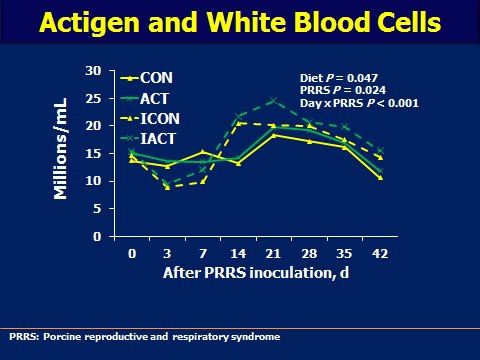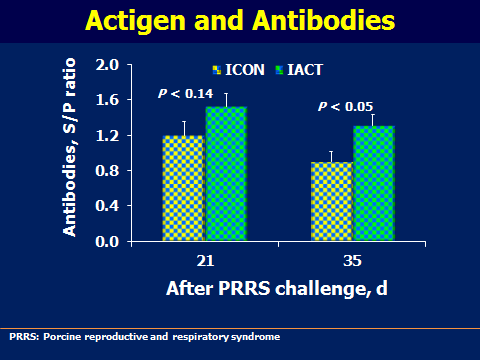When it comes to swine disease challenges, look at the close-out data and other production records. They will tell you that the healthy groups of pigs are more productive, more efficient and more profitable than the less-healthy ones.
It’s a challenge to keep pigs healthy. That’s why we put so much emphasis on powerful management techniques such as all-in/all-out pig flow, intense biosecurity measures, rigorous sanitation, vaccines and others. Even when we apply all of these techniques, pigs may still get sick.
The troublesome diseases are both viral and bacterial, and they are respiratory, enteric and others. Viral diseases may be especially difficult to control. Porcine reproductive and respiratory syndrome (PRRS) is caused by a virus and is generally considered the most troublesome disease in the industry, but other viruses including circovirus and swine influenza virus also demand attention. Some vaccines against viral diseases are very effective, but others are less reliable. Antibiotics can help control secondary bacterial infections but they are powerless against the viruses themselves.
but other viruses including circovirus and swine influenza virus also demand attention. Some vaccines against viral diseases are very effective, but others are less reliable. Antibiotics can help control secondary bacterial infections but they are powerless against the viruses themselves.
Unfortunately, viral diseases can depress the immune system and therefore make animals more susceptible to secondary infections. Fortunately, there are other tools that can help defend pigs against viral diseases through impacts on immune function, with mannan products derived from yeast cell walls prominent among them.
Yeast cell walls are complex structures, but our focus here is on two types of carbohydrates that they contain. One type is beta-glucans, which have long been recognized as immunostimulants. The other type is characterized by chains of mannose units (mannans). We suspect their benefits derive from binding to mannose receptors on the surface of immune cells.
The natural mannan rich fraction of carbohydrate (MRF) (ActigenTM, Alltech) has been shown to block unfavorable organisms from the gut. This carbohydrate supports nutrient utilization, maintains digestive function and enzyme activity, controls inflammation and reduces the gap between ideal and actual performance (Che et al., 2011; Samuel et al., 2012; Xiao et al., 2010). These mechanisms are backed by nutrigenomics research.
During one of our disease challenge experiments with PRRS at the University of Illinois, w e tested the effect of MRF (Actigen 0.4% of the diet) fed to pigs that were challenged at five weeks of age with a standard dose of PRRS virus in special disease-containment chambers at the University of Illinois. We confirmed that none of the pigs had either PRRS virus or PRRS-specific antibody in the blood before the challenge. The challenged pigs became sick; they developed a mild fever and their growth rate during the first two weeks was 60 percent slower than that of the non-challenged control pigs. PRRS impaired feed efficiency (P < 0.001) during the first two weeks and again four to six weeks after the challenge, but during the later period (four to six weeks) MRF overcame the detrimental effect of PRRS (interaction, P = 0.04; Actigen, P < 0.01). Feed/Gain ratios of non-challenged and challenged pig during that period were 2.06 and 2.80 for pigs fed the control diet; 1.90 and 1.97 for those fed MRF.
An important defensive response of the body to infection is an increase in the populations of white blood cells (immune cells in the blood). However, in the case of viral infections there is often an initial change in the opposite direction, a reduction in the numbers of white blood cells. That reduction happened in the MRF experiment during the first week after infection (Figure 1), as in all of our other PRRS-challenge experiments. Perhaps this reduction in the number of white blood cells is one of the mechanisms through which a PRRS infection impairs the pig’s defenses and makes it more susceptible to secondary infections. After the white blood cell numbers dip for one week, they rebound to levels higher than in the healthy pig.
Feeding MRF increased white blood cell numbers (Figure 1), presumably part of a stronger defense against infection. There was some indication that MRF may have quickened the recovery from the very low levels soon after infection, with more white blood cells by week one post-challenge. Whether this response to MRF may enhance protection against secondary infections is not clear, but that appears to be possible. The controlled environment in which we performed this study did not allow secondary infections.
The pattern of white blood cell counts shown in Figure 1 is mimicked by subpopulations of those cells, including total lymphocytes, B lymphocytes (the ones that make antibodies), T lymphocytes, and natural killer cells.
Finally, feeding MRF to challenged pigs increased (P = 0.04) the levels of PRRS-specific antibodies in blood at 35 days after infection, with a tendency in that direction at 21 days (Figure 2). This effect is entirely consistent with the increase in number of B-lymphocytes. It may be important for recovery and for resistance to reinfection with PRRS.
A parallel experiment tested the effects of mannan oligosaccharides (MOS) (Bio-Mos®, Alltech) of the outer cell wall of a specific strain of yeast in the face of a similar challenge with PRRS virus. MOS also provided benefits to infected pigs. However, some details of the impact on the immune response differed between MRF and MOS. Those differences lead to the conclusion that mannan-containing products derived from the yeast cell wall do not all have the same effects.
In conclusion, MRF will not prevent pigs from getting PRRS, and it will not cure them immediately. However, results show that feeding MRF in the face of a PRRS outbreak is likely to improve the health and production of the pigs.

Figure 1. Influence of PRRS infection and MRF on white blood cell counts. CON: uninfected pigs fed control diet; ACT: uninfected pigs fed diet containing 0.4% Actigen; ICON: infected pigs fed control diet; IACT: infected pigs fed diet containing 0.4% Actigen.

Figure 2. Influence of PRRS infection and Actigen on PRRS-specific antibody in serum. ICON: infected pigs fed control diet; IACT: infected pigs fed diet containing 0.4% Actigen. Uninfected pigs had no PRRS-specific antibody.
Editor’s Note: This commentary is sponsored by Alltech, Inc. For more information on animal health and nutrition, go to:www.alltech.com
This commentary is for informational purposes only. The opinions and comments expressed herein represent the opinions of the author--they do not necessarily reflect the opinion of Farms.com. This commentary is not intended to provide individual advice to anyone. Farms.com will not be liable for any errors or omissions in the information, or for any damages or losses in any way related to this commentary.